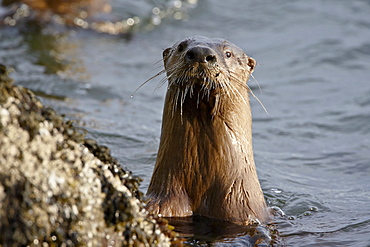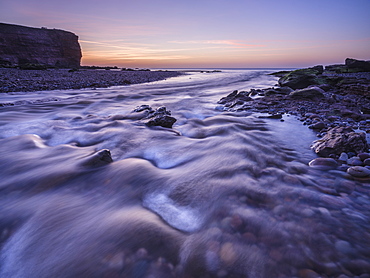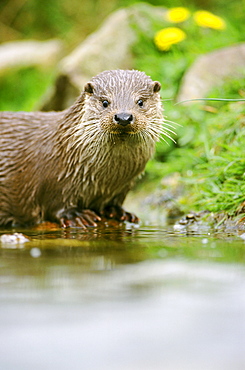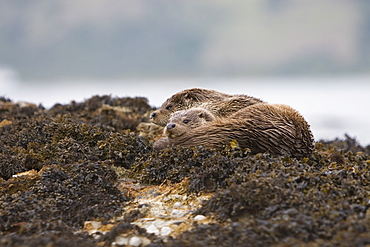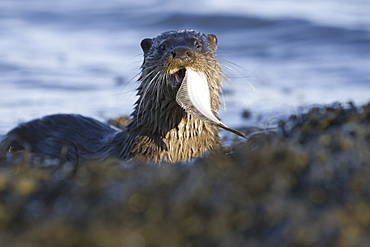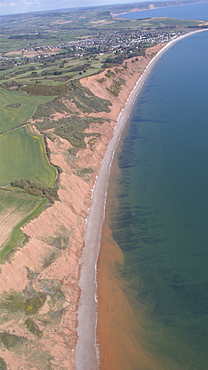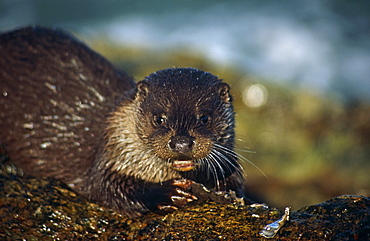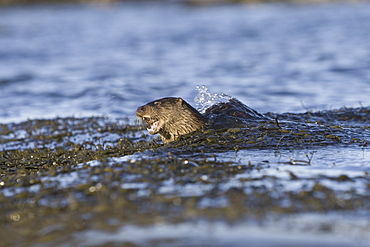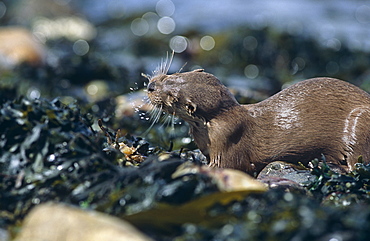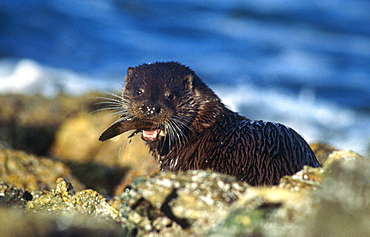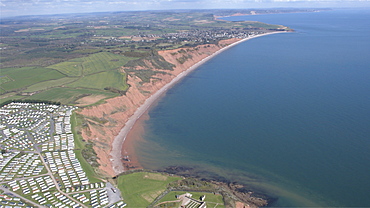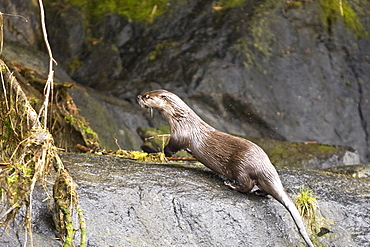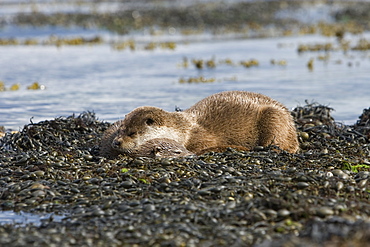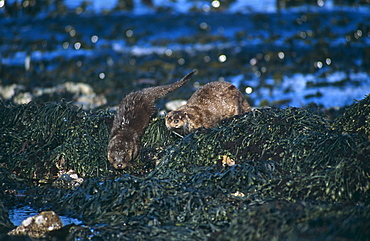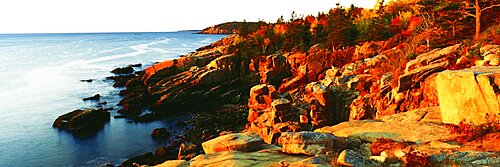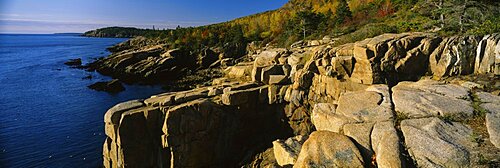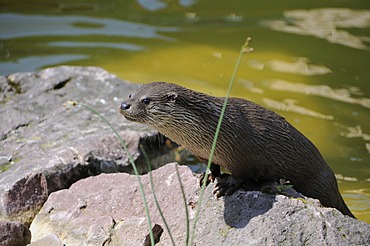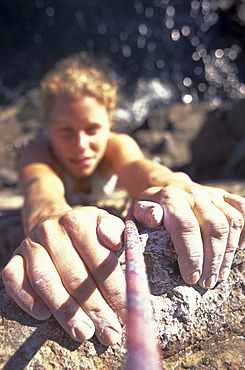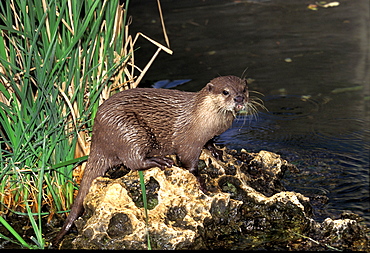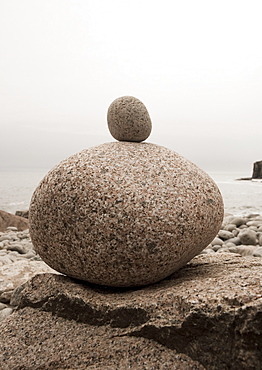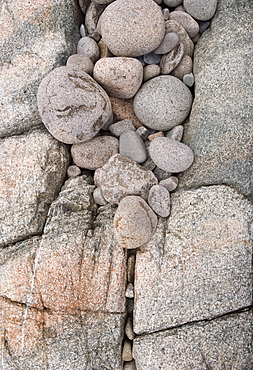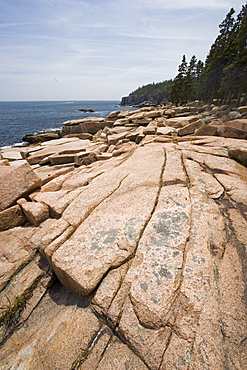Results
11 results found
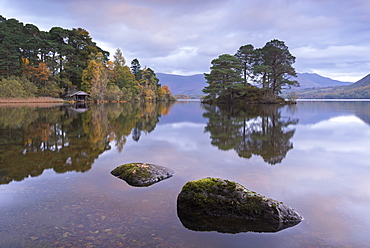
Otter Island near the southern shores of Derwent Water, Lake District National Park, Cumbria, England, United Kingdom, Europe
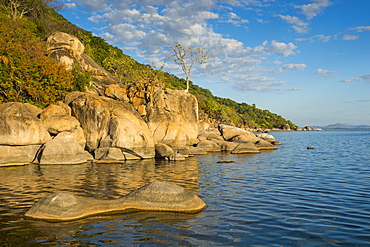
Otter Point at sunset, Cape Maclear, Lake Malawi National Park, UNESCO World Heritage Site, Malawi, Africa
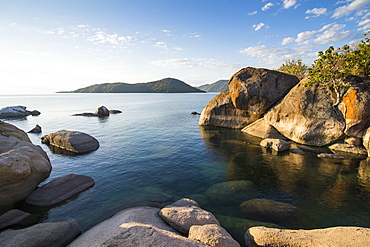
Otter Point at sunset, Lake Malawi National Park, UNESCO World Heritage Site, Cape Maclear, Malawi, Africa
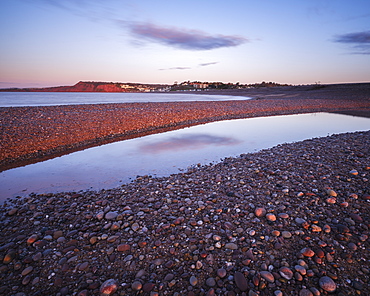
First sunlight falls on Budliegh Salterton with pebbles on the curving beach from Otter Mouth, Budleigh Salterton, Devon, England, United Kingdom, Europe
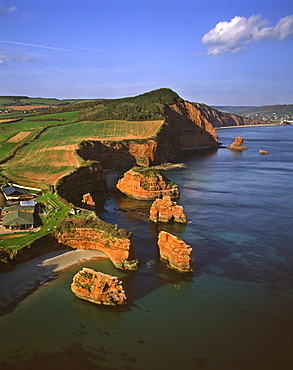
Aerial image of Rock Stacks, Otter Sandstone of Triassic age, Ladram Bay, Devon, England, United Kingdom, Europe
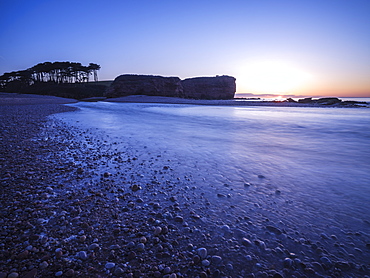
Sunrise behind the silhouetted cliff of Otter Head, where the River Otter meets the sea at Budleigh Salterton, Devon, England, United Kingdom, Europe
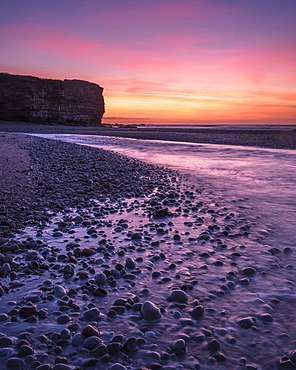
The River Otter meets the sea with strong dawn colour, wet pebbles and the cliff of Otter Head at Budleigh Salterton, Devon, England, United Kingdom, Europe
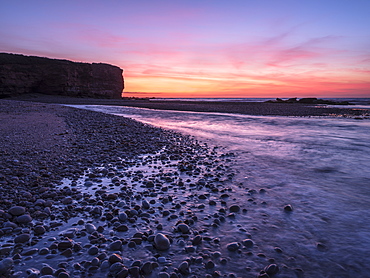
The River Otter meets the sea with strong dawn colour, wet pebbles and the cliff of Otter Head at Budleigh Salterton, Devon, England, United Kingdom, Europe
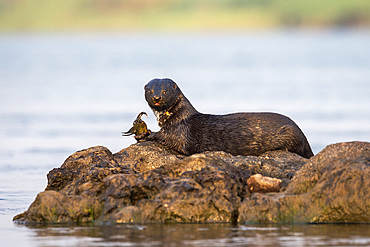
Spotted necked otter (Hydrictis maculicollis) eating leopard squeaker fish, Chobe River, Botswana, Africa
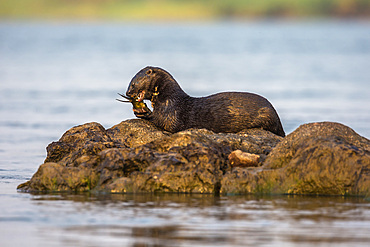
Spotted necked otter (Hydrictis maculicollis) eating leopard squeaker fish, Chobe River, Botswana, Africa
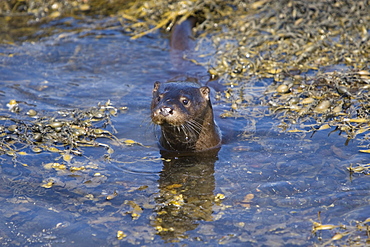
Eurasian river otter (Lutra lutra) foraging in and among the seaweed. Otters on Scotland's west coast and islands have adapted well to making a living in the marine environment. Hebrides, Scotland (RR)
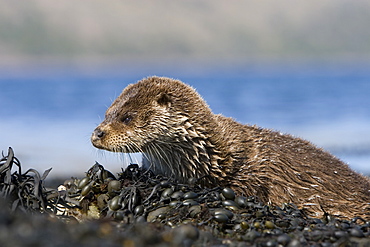
Eurasian river otter (Lutra lutra) resting on seaweed. Otters spend a great deal of time resting ashore, usually near to the water's edge. This time is spent sleeping and preening fur etc. Visits ashore may also be to find fresh water to drink. Hebrides, Scotland
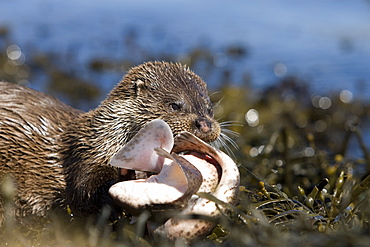
Eurasian river otter (Lutra lutra) eating Greater spotted dogfish (Scyliorhinus stellaris). The otter took only the innards of the dogfish by opening a short section of skin behind the pectoral fin (see images under 'Greater spotted dogfish'). The rest of the fish, still alive, was left on the shore and never retrieved. Perhaps the tough shark skin and battling fish are too much work when other food is plentiful? Hebrides, Scotland
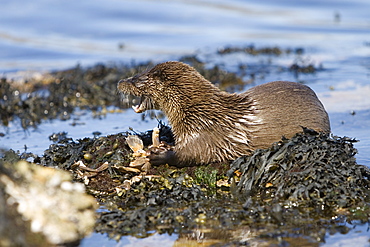
Eurasian river otter (Lutra lutra) eating a large crab. Large fish and crabs are difficult to constrain and eat in the water so are often brought ashore. Otters will sometimes swim realtively long distances in order to do so. Hebrides, Scotland
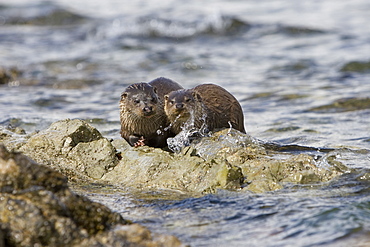
Eurasian river otter (Lutra lutra) mother eating fish with cub closeby. The cub tried unsuccessfully to obtain some of its mother's catch. Hebrides, Scotland
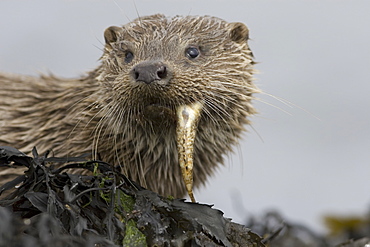
Eurasian river otter (Lutra lutra) eating fish. Otters have adapted well to the marine environment but require sources of fresh water to drink and to clean fur. Hebrides, Scotland
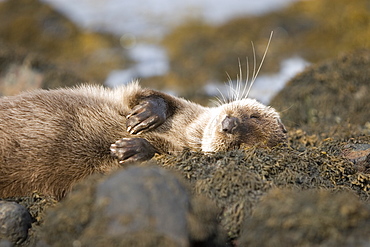
Eurasian river otter (Lutra lutra) resting in the seaweed and rocks. Otters spend a great deal of time resting, usually close to the water's edge or on rocks just offshore. This time is spent sleeping and preening fur etc. Notice the recent injuries sustained by this otter around the head and neck area. Hebrides, Scotland
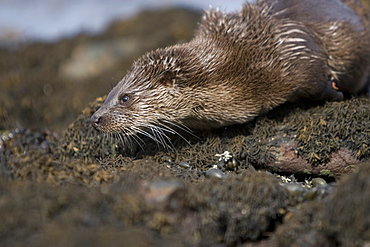
Eurasian river otter (Lutra lutra) resting in the seaweed and rocks. Otters spend a great deal of time resting, usually close to the water's edge or on rocks just offshore. This time is spent sleeping and preening fur etc. Notice the recent injuries sustained by this otter around the head and neck area. Hebrides, Scotland
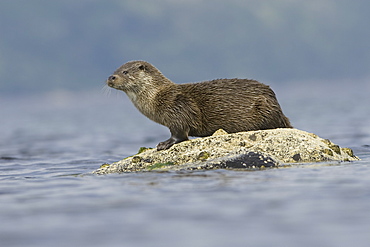
Eurasian river otter (Lutra lutra). Otters in western Scotland have adapted well to life in a marine environment, though proximity to sources of fresh water is essential. Hebrides, Scotland
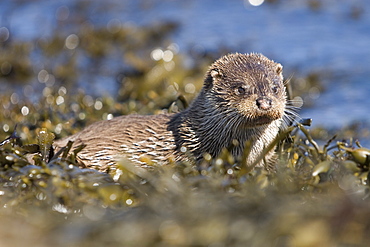
Eurasian river otter (Lutra lutra) having caught Greater spotted dogfish (Scyliorhinus stellaris). The otter took only the innards of the dogfish by opening a short section of skin behind the pectoral fin (see images under 'Greater spotted dogfish'). Hebrides, Scotland (RR)
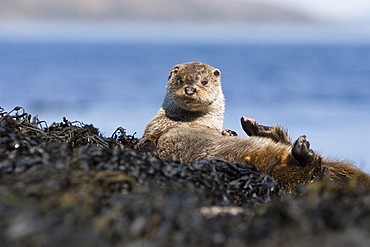
Eurasian river otter (Lutra lutra) resting on seaweed. Otters spend a great deal of time resting ashore, usually near to the water's edge. This time is spent sleeping and preening fur etc. Visits ashore may also be to find fresh water to drink. Hebrides, Scotland
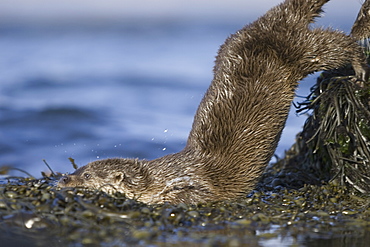
Eurasian river otter (Lutra lutra). Otters in western Scotland have adapted well to life in a marine environment, though proximity to sources of fresh water is essential. Hebrides, Scotland
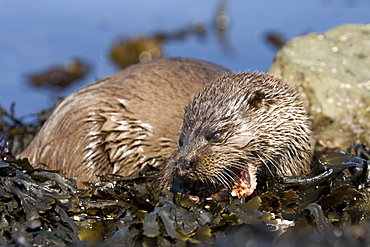
Eurasian river otter (Lutra lutra) eating fish, long-spined bullhead (Taurulus bubalis). Hebrides, Scotland
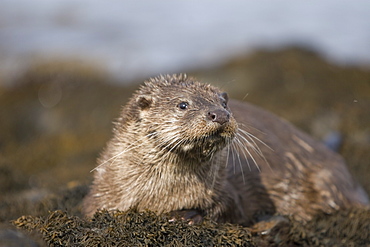
Eurasian river otter (Lutra lutra) resting in the seaweed and rocks. Otters spend a great deal of time resting, usually close to the water's edge or on rocks just offshore. This time is spent sleeping and preening fur etc. Notice the recent injuries sustained by this otter around the head and neck area. Hebrides, Scotland
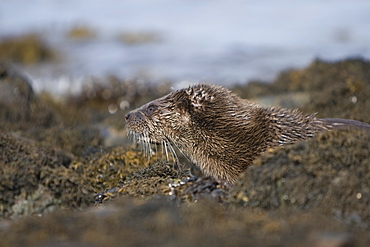
Eurasian river otter (Lutra lutra) resting in the seaweed and rocks. Otters spend a great deal of time resting, usually close to the water's edge or on rocks just offshore. This time is spent sleeping and preening fur etc. Notice the recent injuries sustained by this otter around the head and neck area. Hebrides, Scotland
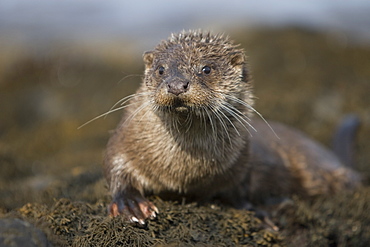
Eurasian river otter (Lutra lutra) resting in the seaweed and rocks. Otters spend a great deal of time resting, usually close to the water's edge or on rocks just offshore. This time is spent sleeping and preening fur etc. Notice the recent injuries sustained by this otter around the head and neck area. Hebrides, Scotland
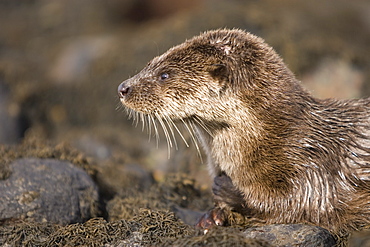
Eurasian river otter (Lutra lutra) resting in the seaweed and rocks. Otters spend a great deal of time resting, usually close to the water's edge or on rocks just offshore. This time is spent sleeping and preening fur etc. Notice the recent injuries sustained by this otter around the head and neck area. Hebrides, Scotland
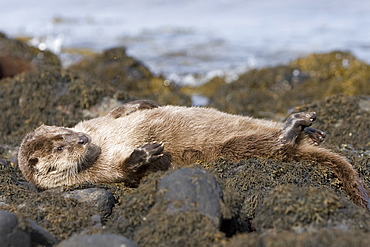
Eurasian river otter (Lutra lutra) resting in the seaweed and rocks. Otters spend a great deal of time resting, usually close to the water's edge or on rocks just offshore. This time is spent sleeping and preening fur etc. Notice the recent injuries sustained by this otter around the head and neck area. Hebrides, Scotland
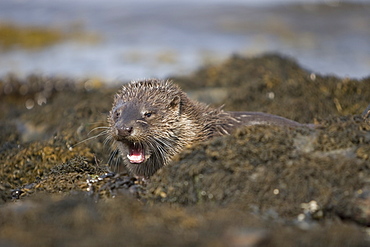
Eurasian river otter (Lutra lutra) resting in the seaweed and rocks. Otters spend a great deal of time resting, usually close to the water's edge or on rocks just offshore. This time is spent sleeping and preening fur etc. Notice the recent injuries sustained by this otter around the head and neck area. Hebrides, Scotland
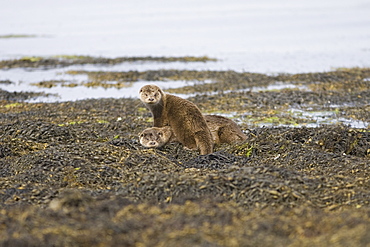
Eurasian river otters (Lutra lutra) resting. Otters take regular breaks during their foraging activities, often choosing high points or islets just offshore in order to sleep, preen and play. Hebrides, Scotland
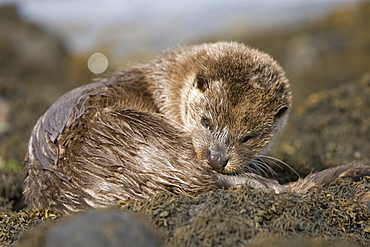
Eurasian river otter (Lutra lutra) resting in the seaweed and rocks. Otters spend a great deal of time resting, usually close to the water's edge or on rocks just offshore. This time is spent sleeping and preening fur etc. Notice the recent injuries sustained by this otter around the head and neck area. Hebrides, Scotland
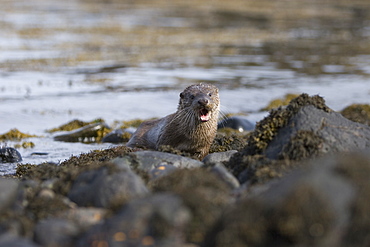
Eurasian river otter (Lutra lutra) foraging in and among the seaweed. Otters on Scotland's west coast and islands have adapted well to making a living in the marine environment. Hebrides, Scotland
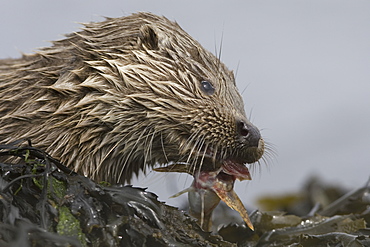
Eurasian river otter (Lutra lutra) eating fish. Otters have adapted well to the marine environment but require sources of fresh water to drink and to clean fur. Hebrides, Scotland
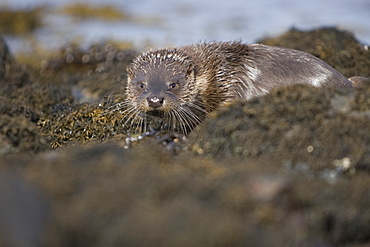
Eurasian river otter (Lutra lutra) resting in the seaweed and rocks. Otters spend a great deal of time resting, usually close to the water's edge or on rocks just offshore. This time is spent sleeping and preening fur etc. Notice the recent injuries sustained by this otter around the head and neck area. Hebrides, Scotland
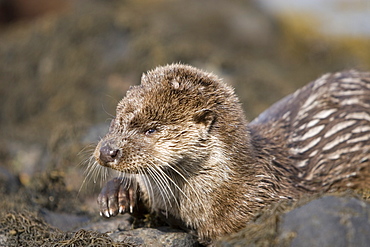
Eurasian river otter (Lutra lutra) resting in the seaweed and rocks. Otters spend a great deal of time resting, usually close to the water's edge or on rocks just offshore. This time is spent sleeping and preening fur etc. Notice the recent injuries sustained by this otter around the head and neck area. Hebrides, Scotland
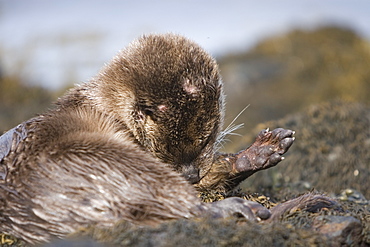
Eurasian river otter (Lutra lutra) resting in the seaweed and rocks. Otters spend a great deal of time resting, usually close to the water's edge or on rocks just offshore. This time is spent sleeping and preening fur etc. Notice the recent injuries sustained by this otter around the head and neck area. Hebrides, Scotland
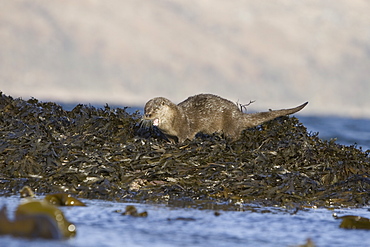
Eurasian river otter (Lutra lutra) sprainting on high point. The spraint is a method of marking territory and high points are a favoured location, even those washed by tides.
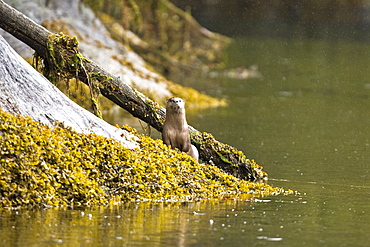
An adult north American river otter (Lutra canadensis) in Misty Fjords National Monument, southeast Alaska, USA.
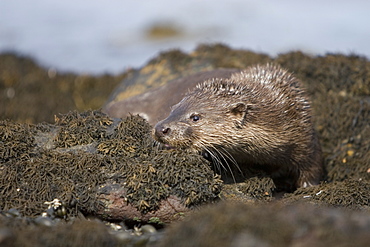
Eurasian river otter (Lutra lutra) resting in the seaweed and rocks. Otters spend a great deal of time resting, usually close to the water's edge or on rocks just offshore. This time is spent sleeping and preening fur etc. Notice the recent injuries sustained by this otter around the head and neck area. Hebrides, Scotland
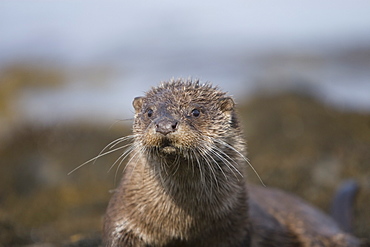
Eurasian river otter (Lutra lutra) resting in the seaweed and rocks. Otters spend a great deal of time resting, usually close to the water's edge or on rocks just offshore. This time is spent sleeping and preening fur etc. Notice the recent injuries sustained by this otter around the head and neck area. Hebrides, Scotland
